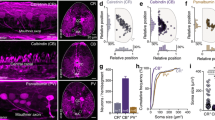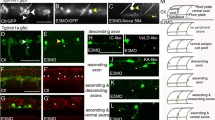Abstract
Additive neurogenesis, the net increase in neuronal numbers by addition of new nerve cells to existing tissue, forms the basis for indeterminate spinal cord growth in brown ghost knifefish (Apteronotus leptorhynchus). Among the cells generated through the activity of adult neural stem cells are electromotoneurons, whose axons constitute the electric organ of this weakly electric fish. Electromotoneuron development is organized along a caudo-rostral gradient, with the youngest and smallest of these cells located near the caudal end of the spinal cord. Electromotoneurons start expressing calbindin-D28k when their somata have reached diameters of approximately 10 μm, and they continue expression after they have grown to a final size of about 50 μm. Calbindin-D28k expression is significantly increased in young neurons generated in response to injury. Immunohistochemical staining against caspase-3 revealed that electromotoneurons in both intact and regenerating spinal cord are significantly less likely to undergo apoptosis than the average spinal cord cell. We hypothesize that expression of calbindin-D28k protects electromotoneurons from cell death; and that the evolutionary development of such a neuroprotective mechanism has been driven by the indispensability of electromotoneurons in the fish’s electric behavior, and by the high size-dependent costs associated with their production or removal upon cell death.








Similar content being viewed by others
References
Bass AH (1986) Electric organs revisited: evolution of a vertebrate communication and orientation organ. In: Bullock TH, Heiligenberg W (eds) Electroreception. Wiley, New York, pp 13–70
Bellido T, Huening M, Raval-Pandya M, Manolagas SC, Christakos S (2000) Calbindin-D28k is expressed in osteoblastic cells and suppresses their apoptosis by inhibiting caspase-3 activity. J Biol Chem 275:26328–26332
Bennett MVL (1971) Electric organs. In: Hoar WS, Randall DJ (eds) Fish Physiology, vol 5. Sensory systems and electric organs. Academic Press, New York, pp 347–491
Bu J, Sathyendra V, Nagykery N, Geula C (2003) Age-related changes in calbindin-D28k, calretinin, and parvalbumin-immunoreactive neurons in the human cerebral cortex. Exp Neurol 182:220–231
Choi W-S, Lee E, Lim J, Oh YJ (2008) Calbindin-D28 K prevents drug-induced dopaminergic neuronal death by inhibiting caspase and calpain activity. Biochem Biophys Res Commun 371:127–131
Fan Y, Shi L, Gu Y, Zhao Y, Xie J, Qiao J, Yang G-Y, Wang Y, Lu C-Z (2007) Pretreatment with PTD-calbindin D 28 k alleviates rat brain injury induced by ischemia and reperfusion. J Cereb Blood Flow Metab 27:719–728
Geula C, Bu J, Nagykery N, Scinto LFM, Chan J, Joseph J, Parker R, Wu C-K (2003) Loss of calbindin-D28k from aging human cholinergic basal forebrain: relation to neuronal loss. J Comp Neurol 455:249–259
Iacopino AM, Christakos S (1990) Specific reduction of calcium-binding protein (28-kilodalton calbindin-D) gene expression in aging and neurodegenerative diseases. Proc Natl Acad Sci USA 87:4078–4082
Iacopino A, Christakos S, German D, Sonsalla PK, Altar CA (1992) Calbindin-D28K-containing neurons in animal models of neurodegeneration: possible protection from excitotoxicity. Mol Brain Res 13:251–261
Ilieş I, Sîrbulescu RF, Zupanc GKH (2014a) Indeterminate body growth and lack of gonadal decline in the brown ghost knifefish (Apteronotus leptorhynchus), an organism exhibiting negligible brain senescence. Can J Zool 92:947–953
Ilieş I, Traniello IM, Sîrbulescu RF, Zupanc GKH (2014b) Determination of relative age using growth increments of scales as a minimally invasive method in the tropical freshwater Apteronotus leptorhynchus. J Fish Biol 84:1312–1325
Ilieş I, Sipahi R, Zupanc GKH (2018) Growth of adult spinal cord in knifefish: development and parametrization of a distributed model. J Theor Biol 437:101–114
Kishimoto J, Tsuchiya T, Cox H, Emson PC, Nakayama Y (1998) Age-related changes of calbindin-D28 k, calretinin, and parvalbumin mRNAs in the hamster brain. Neurobiol Aging 19:77–82
Kook S-Y, Jeong H, Kang MJ, Park R, Shin HJ, Han S-H, Son SM, Song H, Baik SH, Moon M, Yi EC, Hwang D, Mook-Jung I (2014) Crucial role of calbindin-D28k in the pathogenesis of Alzheimer’s disease mouse model. Cell Death Differ 21:1575–1587
Lindsey BW, Tropepe V (2006) A comparative framework for understanding the biological principles of adult neurogenesis. Prog Neurobiol 80:281–307
Murayama N, Noshita T, Ogino R, Masuda T, Kadoshima T, Oka T, Ueno N, Takemoto N, Toba T, Ueno S, Schulze W, Igawa Y, Morita Y, Inoue T (2015) SUN11602-induced hyperexpression of calbindin D-28 k is pivotal for the survival of hippocampal neurons under neurotoxic conditions. Brain Res 1594:71–81
Pappas GD, Waxman SG, Bennett MVL (1975) Morphology of spinal electromotor neurons and presynaptic coupling in the gymnotid Sternarchus albifrons. J Neurocytol 4:469–478
Seki T, Sawamoto K, Parent JM, Alvarez-Buylla A (eds) (2011) Neurogenesis in the adult brain I: neurobiology. Springer, Tokyo
Sîrbulescu RF, Zupanc GKH (2009) Dynamics of caspase-3-mediated apoptosis during spinal cord regeneration in the teleost fish, Apteronotus leptorhynchus. Brain Res 1304:14–25
Sîrbulescu RF, Zupanc GKH (2011) Spinal cord repair in regeneration-competent vertebrates: adult teleost fish as a model system. Brain Res Rev 67:73–93
Sîrbulescu RF, Zupanc GKH (2013) Neuronal regeneration. In: Evans DH, Claiborne JB, Currie S (eds) The physiology of fishes. CRC Press, Boca Raton, pp 405–441
Sîrbulescu RF, Ilieş I, Zupanc GKH (2009) Structural and functional regeneration after spinal cord injury in the weakly electric teleost fish, Apteronotus leptorhynchus. J Comp Physiol A 195:699–714
Sîrbulescu RF, Ilieş I, Meyer A, Zupanc GKH (2017) Additive neurogenesis supported by multiple stem cell populations mediates adult spinal cord development: a spatiotemporal statistical mapping analysis in a teleost model of indeterminate growth. Dev Neurobiol 77:1269–1307
Slee EA, Adrain C, Martin SJ (2001) Executioner caspase-3, -6, and -7 perform distinct, non-redundant roles during the demolition phase of apoptosis. J Biol Chem 276:7320–7326
Spruill MM, Kuncl RW (2015) Calbindin-D28K is increased in the ventral horn of spinal cord by neuroprotective factors for motor neurons. J Neurosci Res 93:1184–1191
Sun S, Li F, Gao X, Zhu Y, Chen J, Zhu X, Yuan H, Gao D (2011) Calbindin-D28 K inhibits apoptosis in dopaminergic neurons by activation of the PI3-kinase-Akt signaling pathway. Neuroscience 199:359–367
Thorns V, Licastro F, Masliah E (2001) Locally reduced levels of acidic FGF lead to decreased expression of 28-kDa calbindin and contribute to the selective vulnerability of the neurons in the entorhinal cortex in Alzheimer’s disease. Neuropathology 21:203–211
Yenari MA, Minami M, Sun GH, Meier TJ, Kunis DM, McLaughlin JR, Ho DY, Sapolsky RM, Steinberg GK (2001) Calbindin D28 k overexpression protects striatal neurons from transient focal cerebral ischemia. Stroke 32:1028–1035
Yuan H-H, Chen R-J, Zhu Y-H, Peng C-L, Zhu X-R (2013) The neuroprotective effect of overexpression of calbindin-D28k in an animal model of Parkinson’s disease. Mol Neurobiol 47:117–122
Zupanc GKH, Bullock TH (2005) From electrogenesis to electroreception: an overview. In: Bullock TH, Hopkins CD, Popper AN, Fay RR (eds) Electroreception. Springer, New York, pp 5–46
Zupanc GKH, Horschke I (1995) Proliferation zones in the brain of adult gymnotiform fish: a quantitative mapping study. J Comp Neurol 353:213–233
Zupanc GKH, Sîrbulescu RF (2013) Teleost fish as a model system to study successful regeneration of the central nervous system. Curr Top Microbiol Immunol 367:193–233
Zupanc MM, Zupanc GKH (2006) Upregulation of calbindin-D28k expression during regeneration in the adult fish cerebellum. Brain Res 1095:26–34
Zupanc GKH, Horschke I, Ott R, Rascher GB (1996) Postembryonic development of the cerebellum in gymnotiform fish. J Comp Neurol 370:443–464
Acknowledgements
We thank Ruxandra F. Sîrbulescu for her suggestions on BrdU labeling of electromotoneurons, and two anonymous reviewers for their helpful comments on the manuscript. Funding for this investigation was provided by Northeastern University and National Science Foundation Grant no. 1538505. All animal experiments were approved by the Institutional Animal Care and Use Committee of Northeastern University. All efforts were made to reduce the number of animals used and to minimize suffering.
Author information
Authors and Affiliations
Corresponding author
Additional information
Publisher's Note
Springer Nature remains neutral with regard to jurisdictional claims in published maps and institutional affiliations.
Rights and permissions
About this article
Cite this article
Vitalo, A.G., Ilieş, I. & Zupanc, G.K.H. Calbindin-D28k expression in spinal electromotoneurons of the weakly electric fish Apteronotus leptorhynchus during adult development and regeneration. J Comp Physiol A 205, 595–608 (2019). https://doi.org/10.1007/s00359-019-01343-3
Received:
Revised:
Accepted:
Published:
Issue Date:
DOI: https://doi.org/10.1007/s00359-019-01343-3




